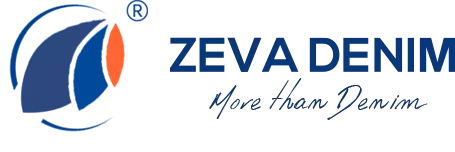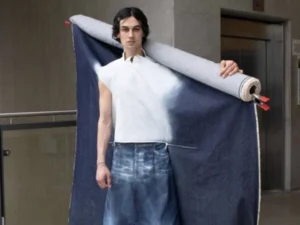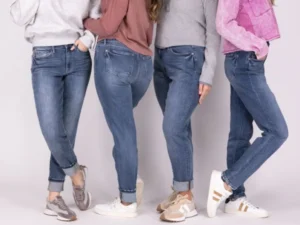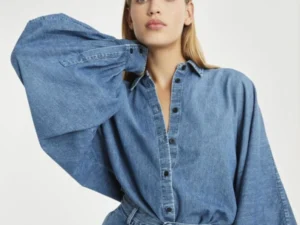In the ever-evolving world of fashion, the choice of fabric plays a vital role in determining the overall outcome and success of a design. An in-depth knowledge of different fabrics enables fashion industry professionals to make informed choices and create garments that satisfy both aesthetic and practical needs.
In this article, we’ll explore two highly versatile fabrics: denim and Wigand. By delving into their unique properties, manufacturing processes, and applications, we aim to clarify the differences between these fabrics and highlight the importance of choosing the correct fabric for a specific purpose.
Denim Overview
- Definition and historical background
Known for its durable yet stylish properties, denim has become synonymous with casual wear around the world. Denim is derived from the French fabric “serge de Nîmes”, which has a long history dating back to the seventeenth century. Originally used in workwear for its sturdiness and durability, denim gained popularity as a fashion fabric in the mid-nineteenth century.
- Manufacturing Process and Composition
Denim is traditionally made from 100% cotton fabric, woven in a twill construction, which is characterized by a twill pattern. The weaving technique helps to increase the strength and durability of the denim. The fabric undergoes a special dyeing process called indigo dyeing, which dyes only the outermost layers of the cotton yarn, resulting in the unique look of denim that fades over time.
- Common uses and features
The versatility of denim allows it to be used in a variety of garments. From signature jeans to jackets and skirts, denim is as comfortable as it is stylish. This fabric is known for its ability to hold its shape, provide breathability, and develop a unique personalized mark over time. Its mid-to-heavy weight makes it suitable for year-round wear in a variety of climates.
Wigan fabrics Overview
- Definition and origin
Originating from the town of Wigan in Lancashire, England, Wigan fabrics occupy a unique place in the textile world. It is often referred to as a lightweight, stiff cotton fabric with a pronounced crisp and almost translucent appearance.
- Composition and Manufacturing Processes
Wigan fabrics are usually made from combed cotton yarns for strength and softness. It undergoes a specialized sizing and finishing process to achieve its characteristic stiffness, allowing it to retain its shape and provide valuable structural support within garment construction.
- Application and Features
Vigan fabrics are mainly used in various areas of garment manufacturing, including collars, cuffs, belts, and interlinings. Its stiffness and stretch make it perfect for adding structure and shape to garments without compromising comfort. The crispness of Wiegand fabric allows it to retain its shape even after repeated washing or pressure.
What Is the Difference Between Denim and Wigan?
Analyze differences
- Abrasion resistance and durability
While denim is known for its strength and durability, Wigand has a different purpose. Denim offers exceptional sturdiness for everyday wear and activities that require abrasion resistance.
On the other hand, the stiffness of the Wiegand fabric gives it structural support and elasticity, which increases the lifespan of the garment.
- Weight and Texture
Denim fabrics range in weight from light to heavy to suit different climates and clothing types. Its texture varies from smooth to a more pronounced twill pattern, adding quite a bit of beauty to fashion designs.
Conversely, the lightweight nature and crisp texture of Wiegand fabrics make them ideal for adding structure without creating bulk or sacrificing comfort.
- Color Choices and Versatility
Denim is most often associated with the classic shade of blue, but it also comes in a variety of colors and washes, offering endless design possibilities.
However, due to its specific manufacturing process, Wiegand fabrics mainly maintain a white or off-white appearance, limiting color options for designers. Despite this limitation, the versatility of Wiegand fabric lies in its ability to enhance the structural elements of a single piece while allowing the outer fabric to take center stage in terms of color and pattern.
Actual comparison
- Examples of denim clothing
The versatility of denim is evident in its many apparel applications. From jeans and shorts to casual jackets and dresses, denim has become a global fashion staple. Its enduring popularity can be attributed to its ability to effortlessly blend comfort, durability, and style.

- Wiegand fabric application
Wiegand fabrics are most commonly used as support textiles in garment construction. It is commonly used on shirt collars, cuffs, waistbands, and as a lining for added stability and shape. While Wiegand fabric is often not visible on the outside of garments, its critical role in maintaining structure and retaining the intended silhouette cannot be underestimated.
Conclusion
In conclusion, knowing the difference between denim and Wigan fabrics allows fashion industry professionals and enthusiasts to make informed decisions based on the unique characteristics of each fabric. Denim’s durability, versatility, and variety of color options make it suitable for a variety of casual clothing.
In contrast, Wiegand fabric’s lightweight properties, stiff texture, and ability to provide structural support make it a key component in making well-structured garments. By choosing the right fabric for a specific application, a fashion design can not only meet its aesthetic requirements but also provide functionality and durability.
As the fashion industry continues to evolve, knowledge of fabrics remains an important foundation for successful and innovative designs.
The above is the whole content of today’s article, thank you for reading!





